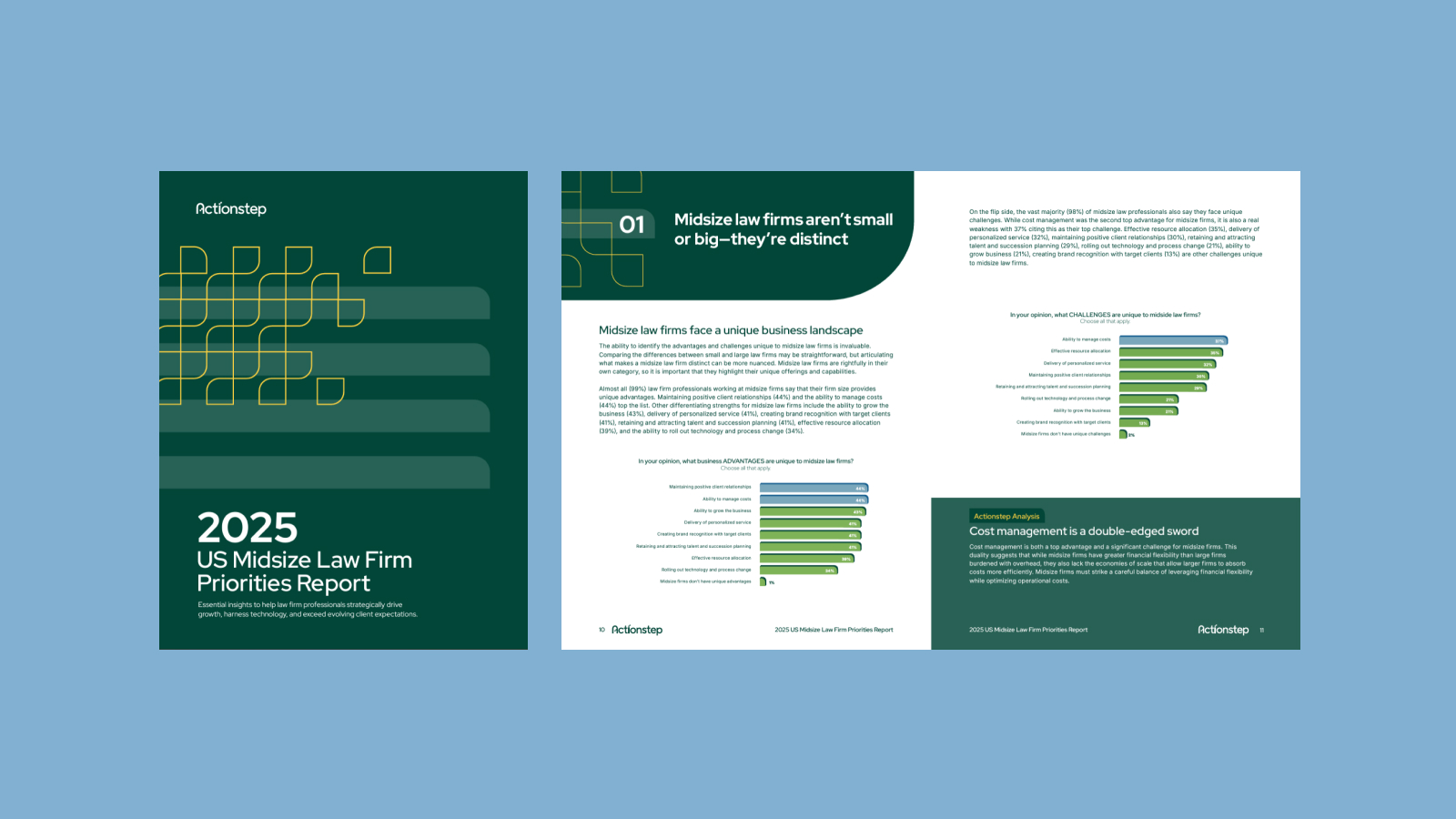9 Best Practices to Improve Your Law Firm Website

9 Best Practices to Improve Your Law Firm Website
When was the last time you took a close look at your law firm’s website? For better or worse, your website is often a prospective client’s first impression of your firm, making it one of your most important marketing tools. Your prospects’ experience on your site will factor into their decision to work with you—or not. So, if your site isn’t telling the story you intend, it’s time to revaluate. Here are nine best practices to get your law firm’s website working for you rather than against you. Addressing these factors will help your site (and your firm) stand out from the competition, garner more leads, and ultimately grow your client base.
Why Invest in Improving Your Law Firm’s Website?
Your own website is the only marketing channel where you have complete control, so it should be one of the primary places you invest your marketing budget. Think of it as a digital storefront for your firm. If a prospective client comes to your site and has a clunky, confusing, or frustrating experience trying to find the information they need, you’ve likely lost the chance to earn their business. They might assume they’ll have a similarly frustrating experience working with your firm. In contrast, if your website is informative, helpful, and intuitive to use, you’ve already started to establish trust and credibility.
Law Firm Website Best Practices
As you make adjustments to your site, it’s important to keep your clients’ point of view and experience top of mind. Law firm websites need to address the specific needs, concerns, and questions of prospective and current clients, so they can’t be designed like any other generic business website. So, what makes a good law firm website? The following best practices will help you get started, whether you’re taking a DIY approach or enlisting the help of web designer/developer or agency.
1. Contemporary, Updated Look
The visual impact that your site makes in terms of fonts, images, colors, and other design elements all play into how your prospective clients see you. In short, looks matter. At minimum, the images on your site should be polished, professional, high-quality, and clear. You should use a limited selection of fonts and colors that have been established as part of your brand.
While all law firm websites need to quickly convey credibility and trustworthiness, it’s also important to consider your specific target audience. For example, Ignition Law’s target clients are entrepreneurs and start-ups, so their website has a clean, tech-savvy, modern design that immediately connects with that audience.

Alternately, the website for a family law firm, or for an elder care law/estate planning practice, should make a different visual impact. For example, Elder Law of East Tennessee’s website conveys compassion and safety.

A note about imagery: Don’t bother with cliché stock photos of leather-bound books, scales of justice, gavels, generic cityscapes, etc. These images look outdated, add clutter, and don’t speak to your specific brand and services. Professional headshots of your staff, along with high-quality photos of your office, will go much further toward engaging potential clients and making them comfortable.
2. Quick Loading Time
People have very little patience when searching online. If your site doesn’t load quickly, prospective clients probably won’t wait around, especially not when browsing on their mobile phones. You can check your website speed on Google’s Test My Site tool to see what, if any, improvements could be made. In many cases, large image files slow down a site’s load speed, so downsizing your images can make a big difference.
3. Mobile-Friendly
Speaking of mobile phones, it’s vital that your site is works just as well on mobile as it does on a desktop browser. In 2021, 55% of page views on the Internet came from mobile phones, so it’s very likely prospective clients are using their phone to look at your site. Your website should be responsive, which means that it automatically adjusts to fit the screen of various mobile devices.
4. Simple Navigation
It should be very easy for prospects to navigate your website, meaning that it’s intuitive for them to find what they’re looking for. If you’re wondering how to test this, try asking someone outside your firm come to your site and see if they can find the basic things a prospect would be looking for. Most often, this includes most often your firm’s areas of practice and/or industries, attorney biographies, and contact information. The main menu (also called the navigation bar) and the search bar should be very prominent.
In this example from Armstrong Teasdale, the navigation bar is clearly visible on the lefthand side. The “What can we do for you?” search bar is also front and center, which makes it easy for clients to find what they need.

5. Accessible Design & ADA Compliance
You want your website to be welcoming and usable for as many people as possible, so the design should take into account users of different physical or situational abilities. For example, if a user is visually impaired, the site should be legible for a screen reader. Avoid using low-contrast text colors, e.g., yellow text on a white background. Don’t use flashing animations or strobe effects. Make sure any videos include captions. These are just a few accessibility considerations; you can find an in-depth overview of website accessibility and Web Content Accessibility Guidelines (WCAG) here, compiled by the World Wide Web Consortium (W3C).
Not only is accessible design a best practice for your website, it’s also becoming a requirement in some places. Some U.S. states have adopted ADA compliance legislation that applies to all commercial websites—meaning businesses can be sued if they’re not compliant.
6. Prominent Contact Information
It might seem like a no-brainer, but you want it to be easy and painless for potential clients to connect with you. Make sure your contact information is in an obvious, accessible place throughout your website. It’s also a good practice to include a dedicated contact page that is linked from your main navigation.
Minc Law’s homepage features all the options for contacting them directly on their homepage, as well as a “Contact” link in their main navigation, so potential clients are not confused or sifting through information to get in touch:

7. Clear Descriptions of Your Services and/or Practice Area(s)
Once you’ve made sure that your website is visually updated, mobile-friendly, and easy to use, a “Services,” “Practices,” or “Industries” page is also an essential element of your site. This is where potential clients can easily learn about the services you offer and how they can benefit from them. Treat this page as an overview of what you do, using clear, understandable language.
There are common search terms that legal consumers type into Google and other search engines, often including their own specific location (example: “Philadelphia law firms”) and/or the specific legal practice area or service they are interested in (example “divorce lawyers in Philadelphia”). To point search engines in the right direction and improve your visibility to potential clients, you need to make sure that these terms appear on your website, particularly on your Services page.
The Services page is also a great place to showcase any written or video testimonials you have from past clients who can vouch for you.
8. Easy-to-Find Attorney Profiles
It’s natural that potential clients want to get to know who they might be working with. Use an “About” page to introduce yourself (and the other attorneys at your firm), explaining what you do, your particular expertise and background, your years of experience, certifications and awards, why what you do matters to you, and how you can help. Include clear, high-quality, professional headshots.
9. Get Some Help
The world of website design can quickly get overwhelming, but luckily there are many resources to help. You can find many companies, webinars, and articles online that discuss how to effectively update law firm websites, and that showcase what good website design looks like for law firms. You could also consider working with a website developer or marketing agency– through them, you can invest in a user experience audit that will tell you valuable information about how users are actually interacting with your site and things you can change or update to improve conversions from visitors to leads.
Next Steps: Measuring Website Success
Once you have an optimized, updated website, it’s critical to think about how you will measure your success. A key to this success is in monitoring the return on the investment your firm makes in your website. Here are a few ways that you can start to measure your efforts:
- Measure traffic to your website through Google Analytics, another free tool from Google. Through Google Analytics, you can see if you’re getting more traffic over time, and also learn how most of that traffic is finding you. These insights can help you understand whether your site is generating more traffic and eventually more leads.
- Legal practice management software can help you manage and track virtually anything, including marketing campaigns and related activities, to create budgets, set timeframes, and gauge results. For example, Actionstep has robust reporting tools where you can also create dashboards, run custom reports, measure your firm’s performance, and identify profit centers and areas of concern.
Want to find out more about how Actionstep can give you better visibility into your firms’ productivity and success? Get in touch with our team today to find out how we can help.


